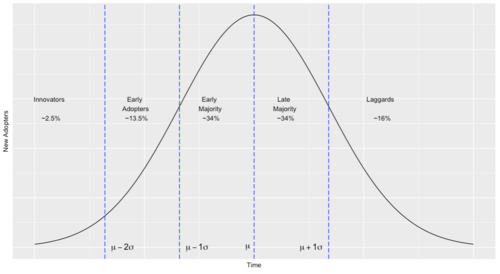By Xue Bai, PhD candidate
Based on the emerging technology, this paper proposes a new method to measure the expected duration of competitive advantage for average adopters. This method is based on public data, such as google searches, press releases, book titles, and companies’ disclosures with respect to the technology. The method is very easy to implement.
Importance: Previous studies focus on the financial pay-off and market reaction to the announcements of investment to measure the benefits of innovations on firms’ operation, but they ignore the adoption of technology. Firms adopting the technology earlier should have a longer duration of competitive advantage. This paper addresses this limitation by focusing on the adoption stage of the technology.
Two assumptions: 1) The normal distribution of adoption cycle; 2) Only three groups of adopters (innovators, early adopters, and early majority) have the competitive advantage. The innovator starts from three standard deviations from the mean; early adopters group starts from two standard deviations from the mean; and the early majority group starts from one standard deviation from the mean and ends at the mean.
Methodology: As more and more companies adopt this technology, the competitive advantage of the technology decreases. Their competitive advantage is measured by the adopters’ assessment of future expected pay-off, and information gathering can help shape adopters’ assessment, such as google searches, press releases, book titles, and companies’ disclosures with respect to the technology. High information volume is related to high expected payoffs. Thus, the technology adoption cycle is based on the distribution of information volume. Based on the distribution of information volume over time, we can get the standard deviation of distribution of information volume to calculate the expected duration of competitive advantage using the equation of 0.87*standard deviation.

Application: Enterprise resource planning (ERP) and cloud computing can provide the potential competitive advantage and have considerable barriers to adoption. In applying the method of this paper to measure the expected competitive duration of ERP and cloud computing, the measures of ERP and cloud computing are consistent with professional reports and previous literature.
Limitations: Firstly, the method is based on a few parameters, and other factors, such as technology and adopters’ attributes, which can lead to more accurate estimates. Secondly, some technologies may experience several hype cycles, and professional judgements are needed to identify the correct hype cycle. Thirdly, it is hard to define when the technology becomes widely used in the market.
The study, A framework for predicting emerging technology adoption, authored by Stratopoulos and Wang is available through SSRN.